Click on images to enlarge
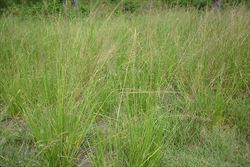
infestation (Photo: Sheldon Navie)
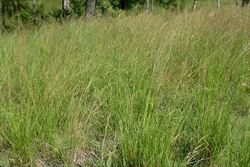
infestation (Photo: Sheldon Navie)
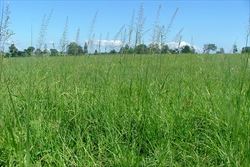
habit (Photo: Sheldon Navie)
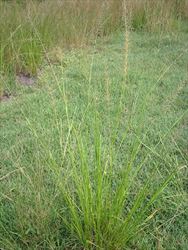
habit with mature seed-heads (Photo: Sheldon Navie)
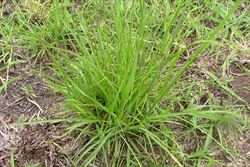
tussock and leaves (Photo: Sheldon Navie)

close-up of stem and leaf (Photo: Sheldon Navie)

younger seed-head (Photo: Sheldon Navie)

mature seed-head with stiffly spreading branches (Photo: Sheldon Navie)

close-up of lower part of seed-head (Photo: Sheldon Navie)

close-up of seed-head in flower (Photo: Sheldon Navie)
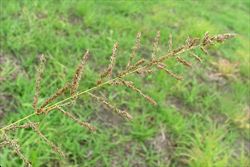
close-up of upper part of seed-head (Photo: Sheldon Navie)
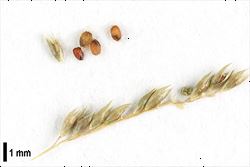
close-up of mature flower spikelets and seeds (Photo: Sangita Shrestha)
Scientific Name
Sporobolus pyramidalis Beauv.
Synonyms
Sporobolus indicus (L.) R. Br. var. pyramidalis (Beauv.) Veldkamp
Family
Gramineae (South Australia)Poaceae (Queensland, New South Wales, the ACT, Victoria, Tasmania, Western Australia and the Northern Territory)
Common Names
cat's tail dropseed, cat's tailgrass, giant rat's tail grass, giant rats tail grass, giant rats-tail grass, giant ratstail grass, GRT, GRT grass, Parramatta grass, West Indies smutgrass, whorled dropseed
Origin
Native to sub-Saharan Africa, Madagascar, Mauritius and parts of the the Arabian Peninsula (i.e. Yemen).
Naturalised Distribution
This species is widely distributed in the eastern parts of Australia. It is most common in the coastal districts of southern Queensland and northern New South Wales. Also relatively common in the coastal districts of central and northern Queensland and recorded from a few locations in the Northern Territory.
Habitat
A weed of pastures, roadsides, disturbed sites, open woodlands, grasslands, parks, footpaths and lawns in sub-tropical, tropical and sometimes also warmer temperate regions.
Habit
An upright (i.e. erect) and long-lived (i.e. perennial) grass, growing 90-200 cm tall, that forms large dense tussocks.
Distinguishing Features
- an upright and long-lived grass growing 90-200 cm tall and forming large tussocks.
- its very long and narrow leaf blades (20-70 cm long and 3-10 mm wide) may be flat or somewhat rolled.
- its elongated, pyramid-shaped, seed-heads (20-45 cm long and about 3 cm wide) have many short branches.
- these seed-head branches are initially held closely to the stem, but as the seed-head opens they become stiffly spreading.
- each of these branches bears numerous tiny flower spikelets (1.7-2.2 mm long).
Stems and Leaves
The flowering stems (i.e. culms) are 2-5 mm thick and somewhat wiry.
The leaves are very elongated (i.e. linear) with a leaf sheath, which partially encloses the stem, and a spreading leaf blade that may droop towards the ground. The leaf sheaths are hairless (i.e. glabrous), or have some tiny hairs along their margins, and the leaf blades may be flat or somewhat rolled (i.e. convolute). These leaf blades (20-70 cm long and 3-10 mm wide) are hairless (i.e. glabrous), or have some tiny hairs along their margins, and have pointed tips (i.e. acuminate apices). Where the sheath meets the leaf blade there is a fringe of tiny hairs or a very short membrane (0.2-0.3 mm long) topped with tiny hairs (i.e. the ligule is ciliate or a ciliated membrane).
Flowers and Fruit
The elongated seed-heads are borne at the top of the stems and are initially thin in nature (i.e. spiciform), but become more open and narrowly pyramid-shaped (i.e. pyramidal) as they mature. These seed-heads (20-45 cm long) have numerous stiffly spreading branches (5-10 cm long). Each of these branches bears numerous tiny, densely packed, and elongated (i.e. lanceolate) or oval (i.e. elliptic) flower spikelets almost to its base. The dark green or greyish-green flower spikelets (1.7-2.2 mm long) contain a single tiny flower (i.e. floret) inside two bracts (i.e. glumes). The lower bract (i.e. glume) is 0.3-0.5 mm long and the upper bract (i.e. glume) is 0.5-0.8 mm long (i.e. less than half the length of the flower spikelet). Flowering occurs throughout the year, but mainly during spring, summer and autumn.
The tiny seeds (i.e. grains or caryopses) turn yellowish-brown or reddish-brown in colour as they mature. These seeds (0.8-1 mm long and up to 0.5 mm wide) are oblong or egg-shaped (i.e. obovoid) and separate from the remainder of the flower spikelet at maturity (i.e. the pale coloured old glumes remain on the seed-head).
Reproduction and Dispersal
This species produces large quantities of tiny seeds.
These seeds become somewhat sticky when wet, and may be spread after becoming attached to animals, clothing and vehicles. They may also be dispersed by water, in mud, and in contaminated agricultural produce (e.g. fodder and pasture seed lots).
Environmental Impact
Giant rat's tail grass (Sporobolus pyramidalis) is a significant environmental weed in Queensland and northern New South Wales. It was also recently listed as a priority environmental weed in at least one Natural Resource Management region. This species invades native grasslands, open woodlands, conservation reserves and wetland areas. When fully established in an area, it can form a grass monoculture, excluding native plants and reducing biodiversity of native groundcover species. This can also have an impact on native herbivores, which find the plants unpalatable.
Along with Sporobolus natalensis, this species is ranked among the top 25 environmental weeds in south-eastern Queensland. It is also thought to pose a significant threat to rangeland biodiversity in central and northern Queensland, and heavy infestations may also increase fire intensity in sensitive environmental areas. The Giant rat's tail grasses (Sporobolus natalensis and Sporobolus pyramidalis ) are already of concern in several conservation areas in Queensland.
Other Impacts
Giant rat's tail grass (Sporobolus pyramidalis) is a serious weed of pastures in the coastal districts of Queensland and northern New South Wales. It is of low palatability to livestock and can greatly reduce the productivity of agricultural land by completely displacing desirable pasture species. This reduction in productivity can be exhibited in reduced stocking capacities, longer periods of time to record adequate weight gains in beef cattle, and higher costs in milk production on dairy farms. The economic costs incurred in managing this species with herbicides are also quite high, and heavily infested areas have reduced land values. Mature leaf blades and stems are tough for animals to graze, and have been known to loosen the teeth of cattle and horses.
Legislation
This species is declared under legislation in the following states and territories:
- New South Wales: Class 3 - a regionally controlled weed. The relevant local control authority must be promptly notified of the presence of this weed and it must be fully and continuously suppressed and destroyed (in a minority of local authority areas). See the New South Wales Department of Primary Industries Noxious Weeds List at http://www.dpi.nsw.gov.au for more detailed information on which local areas are covered in these declarations.
- Queensland: Class 2 - landowners must take all reasonable steps to keep land free of this species (throughout the entire state). It is also illegal to sell a declared plant or its seed in this state.
- Western Australia: Prohibited - on the prohibited species list and not permitted entry into the state.
Management
For information on the management of this species see the following resources:
- the Biosecurity Queensland Fact Sheet on giant rats tail grass and other weedy Sporobolus species, which is available online at http://www.dpi.qld.gov.au.
Similar Species
Giant rats-tail grass (Sporobolus pyramidalis ) is very similar to other introduced rats-tail grasses (Sporobolus spp.) including another species known as giant rats-tail grass (Sporobolus natalensis), Parramatta grass (Sporobolus africanus), giant Parramatta grass (Sporobolus fertilis ) and American rats-tail grass (Sporobolus jacquemontii ). It is also similar to some native species such as the slender rats-tail grasses (Sporobolus creber and Sporobolus elongatus). Distinguishing between these species is often very difficult and a specialist may need to be consulted, however the following is a guide to the differences that may be apparent:
- giant rats-tail grass (Sporobolus pyramidalis) is a relatively large plant (usually 90-200 cm tall) with relatively large pyramid-shaped (i.e. pyramidal) seed-heads (20-45 cm long). These seed-heads have numerous relatively long branches (50-100 mm long) that stiffly spread away from the main stem. Its flower spikelets are moderately-sized (1.7-2.2 mm long).
- giant rats-tail grass (Sporobolus natalensis) is a relatively large plant (60-150 cm tall) with relatively large spike-like (i.e. spiciform) seed-heads (20-30 cm long). These seed-heads have numerous relatively long branches (30-70 mm long) that usually spread away from the main stem. These branches are normally densely arranged and the seed-head is un-interrupted. Its flower spikelets are moderately-sized (1.6-2.3 mm long).
- Parramatta grass (Sporobolus africanus) is a relatively small plant (usually less than 50 cm tall) with relatively small spike-like (i.e. spiciform) seed-heads (6-35 cm long). These seed-heads have numerous short branches (10-20 mm long) that are usually held closely (i.e. appressed) to the main stem. These branches are normally densely arranged and the seed-head is mostly un-interrupted (except occasionally at the base). Its flower spikelets are relatively large (2-2.8 mm long).
- giant Parramatta grass (Sporobolus fertilis) is a relatively large plant (usually 80-160 cm tall) with relatively large spike-like (i.e. spiciform) seed-heads (15-50 cm long). These seed-heads have numerous moderately long branches (20-80 mm long) that are held closely (i.e. appressed) to the main stem or slightly spreading. These branches are normally densely arranged and the seed-head is mostly un-interrupted (except occasionally at the base). Its flower spikelets are relatively small (1.5-2 mm long).
- American rats-tail grass (Sporobolus jacquemontii) is a moderately-sized plant (usually 50-75 cm tall) with relatively small elongated seed-heads (8-25 cm long). These seed-heads have numerous relatively long branches (50-100 mm long) that usually spread away from the main stem. These branches are normally densely arranged and the seed-head is un-interrupted. Its flower spikelets are relatively small (1.5-2 mm long).
- slender rats-tail grass (Sporobolus creber) is a moderately-sized plant (usually less than 100 cm tall) with relatively long and very narrow spike-like (i.e. spiciform) seed-heads (18-60 cm long). These seed-heads have numerous short stiff branches (5-10 mm long) that are always held closely (i.e. appressed) to the main stem. These branches are normally widely spaced and the seed-head is interrupted (except near the top). Its flower spikelets are relatively small (1.2-1.7 mm long).
- slender rats-tail grass (Sporobolus elongatus) is a moderately-sized plant (usually 50-100 cm tall) with relatively long and narrow spike-like (i.e. spiciform) seed-heads (10-30 cm long). These seed-heads have numerous relatively long branches (40-80 mm long) that are usually held closely (i.e. appressed) to the main stem (sometimes slightly spreading). These branches are normally densely arranged and the seed-head is mostly un-interrupted (except occasionally at the base). Its flower spikelets are moderately-sized (1.5-2.3 mm long).

